One of the wealthiest neighborhoods in Philadelphia is increasing parking requirements and limiting building heights at all costs.

"Mayor Jim Kenney’s first direct veto of City Council legislation — over a bill establishing more restrictive zoning rules for the Society Hill neighborhood — has been reversed by the chamber," Ryan Briggs.
The veto override is the latest in a saga that has changed the fortunes of the downzoning on several occasions. First the Philadelphia City Council approved the rezoning over the objections of planning staff and the city's planning commission. Then Mayor Kenney vetoed the City Council's approval. Now the City Council has overridden that veto.
The Philadelphia City Council's commitment to the downzoning comes despite direct criticism of the exclusionary nature of the changes, and how that approach fits into the contemporary approach to planning in the city (i.e., it doesn’t).
The legislation will "cap the height of development along Walnut Street to just 65 feet, increase parking requirements and eliminate density bonuses granted in exchange for historic preservation," explains Briggs. "The bill would also limit building heights to 45 feet in some areas of the district spanning from Walnut to Lombard Street between 8th and the Delaware River."
The vote did reveal at least some dissent among the council, in a departure from the usual councilmanic prerogative that offers councilmembers control over land use questions in their districts. Four councilmembers voted against the override. The original legislation to implement the rezoning passed the council unanimously. Soundbites included in the article from some of the dissenting councilmembers explain the shift.
FULL STORY: Mayor Kenney’s first 2020 veto reversed in win for Society Hill Civic

Planetizen Federal Action Tracker
A weekly monitor of how Trump’s orders and actions are impacting planners and planning in America.

Congressman Proposes Bill to Rename DC Metro “Trump Train”
The Make Autorail Great Again Act would withhold federal funding to the system until the Washington Metropolitan Area Transit Authority (WMATA), rebrands as the Washington Metropolitan Authority for Greater Access (WMAGA).

The Simple Legislative Tool Transforming Vacant Downtowns
In California, Michigan and Georgia, an easy win is bringing dollars — and delight — back to city centers.

The States Losing Rural Delivery Rooms at an Alarming Pace
In some states, as few as 9% of rural hospitals still deliver babies. As a result, rising pre-term births, no adequate pre-term care and "harrowing" close calls are a growing reality.

The Small South Asian Republic Going all in on EVs
Thanks to one simple policy change less than five years ago, 65% of new cars in this Himalayan country are now electric.

DC Backpedals on Bike Lane Protection, Swaps Barriers for Paint
Citing aesthetic concerns, the city is removing the concrete barriers and flexposts that once separated Arizona Avenue cyclists from motor vehicles.
Urban Design for Planners 1: Software Tools
This six-course series explores essential urban design concepts using open source software and equips planners with the tools they need to participate fully in the urban design process.
Planning for Universal Design
Learn the tools for implementing Universal Design in planning regulations.
Smith Gee Studio
City of Charlotte
City of Camden Redevelopment Agency
City of Astoria
Transportation Research & Education Center (TREC) at Portland State University
US High Speed Rail Association
City of Camden Redevelopment Agency
Municipality of Princeton (NJ)



























